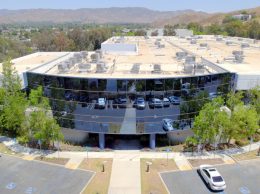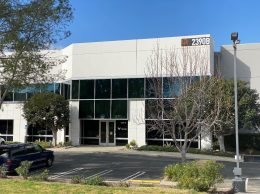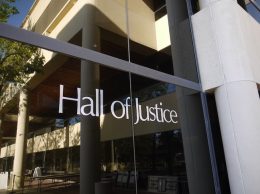Farmers office complex in Simi Valley attracting buyers

The Farmers Insurance Office Complex in Simi Valley is likely to be redeveloped for mixed uses by whoever buys the massive property. (Courtesy photo)
Plans for redeveloping the vacant Farmers Insurance Office Complex in Simi Valley’s city center are beginning to gain momentum.
The mammoth 271,000-square-foot property, an empty shell since 2013, was foreclosed on and then sold a year ago at a trustee’s sale with a declared minimum bid amount of about $20.6 million, according to property records.
Brian Gabler, Simi Valley director of economic development, said the city is working with the property’s current owner, a large national broker and receiver, to sell the property, which is receiving “lots of interest from buyers.”
Currently, he said, potential buyers are submitting bids that will be narrowed down based on input from the city to ensure the development project can proceed through approvals.
“The buyer’s vision has to be the same as our vision,” Gabler said, adding that the space is a prime candidate for a mixed use development. Interested developers have proposed a diverse roster of ideas for the property, he said; and most “would propose to demolish the buildings and begin with a blank slate.”
The property, located at 3041 Cochran St., consists of a parking lot and three structures: a main office building with 240,000 square feet, another office or training center with 21,000 square feet and a warehouse building with 10,000 square feet.
While the city and property owners continue to discuss the complex’s future, regional experts in real estate and architecture offered ideas for potential uses.
“I drive by it probably 20 times a week and wonder ‘Why hasn’t WeWork (a national co-working space) or something else moved in there?” said Jeffrey Peldon, a commercial real estate broker and manager at Century 21 Troop Real Estate.
Because of its vertical space as a five-story building — as opposed to a shorter and more spread-out building that might suit an office park — he suggested it could host a “tech park.” The Simi Valley area doesn’t have a space dedicated to tech startups and companies, Peldon said, which means there’s a strong commercial real estate opportunity for that kind of facility in the region.
The property’s geographical location near Moorpark College and other universities, as well as Simi Valley’s location between the San Fernando Valley, Santa Clarita and Santa Barbara areas — in which tech startups have steadily taken off and continue growing — make it a prime candidate for that kind of development.
The small tech startup culture “seems to have skipped Simi Valley,” Peldon said, and not necessarily because of the location in and of itself. There hasn’t been a space for it because vacancies are “immediately filled with an industrial tenant.”
“A tech startup space would be a great advantage,” he said. “We’re surrounded by the right infrastructure . . . It would be a low cost structure here compared to other valleys.”
Robert Matola, an architect at RM Designs in Simi Valley, suggested the complex be repurposed as an office park for small businesses.
“We have quite a bit of professionals who own and run a business out of their homes,” he said, explaining that a larger space where the cost was shared with others could provide small business owners with professional amenities, such as a conference room, reception area and maybe even an office gym, which they couldn’t afford on their own.
The complex’s large square footage could lend itself to small or medium offices of 1,000-4,000 square feet. If the current building underwent interior renovations and an exterior “facelift,” he said, it could promote a high-end experience for businesses that want to increase visibility and operate in a professional space.
The location has plenty of parking and is easily accessible from the freeway. Modernizing the main building and rebranding it as a contemporary space — with possible renovations including a large cafeteria or restaurant and a parkway area where people could walk and eat lunch — would make the space both professional and attractive.
Matola stressed the importance of designing a project that makes sense for the region, which he said can be a challenge when outside developers unfamiliar with the local area want to develop something that might sound good but ends up being a “complete bust.”
He recommended “taking a very close look at what Simi Valley needs, as opposed to what developers who do not live in Simi Valley think we need . . . I think it’s very important that anyone who does a study on that site and proposes to knock down the building that they have a complete understanding of what it means to be a resident of Simi Valley.”
Matola recommended surveying the community before starting a project. “The last thing we need is another development that looks great and is operating at 60 percent,” he said.
The future of the building remains unclear, but Gabler said the city hopes to have a buyer in coming months.
“We are very excited about the property . . . moving forward, getting a new owner, working with the new owner on the vision for the property and redeveloping the property into something the community can really get behind and support — and that will provide lots of positive benefits to the community,” Gabler said.











